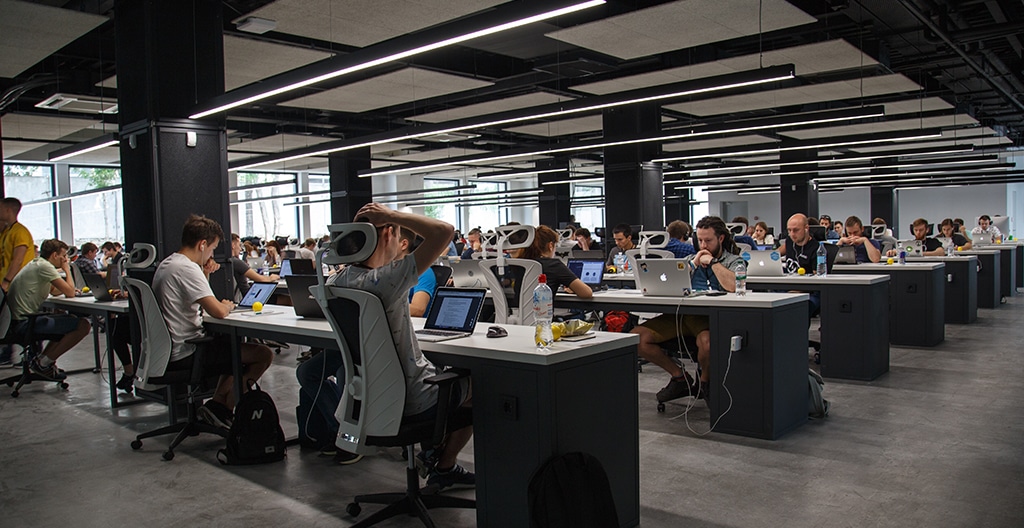
Today, roughly 70% of U.S. offices have few to no partitions, according to the International Facility Management Association. The open-plan office is traced back to “office landscaping,” a design technique pioneered by German consultants Quickborner in the 1950s. Conventional wisdom holds that the absence of walls fosters camaraderie among coworkers. It even spurs impromptu conversations which blossom into innovations. This is, of course, in addition to the fact that a greater number of workers fit in an open-plan office, making it more most cost-effective for many businesses.
The Open Office Today
Although popular for decades, the open-plan office has been the subject of recent spectacle. This is, in part, thanks to the high-profile workplace architecture of established tech giants like Google and Facebook, as well as relative newcomers like Airbnb. In today’s open-plan office a sea of organically arranged half-height cubicles is no longer what you’ll find; it now includes arcades, basketball courts, full-size pirate ships, and hydrogen-bomb-proof greenhouses. The recent past has seen a boom in startups looking to emulate established companies who project their success through creative office aesthetics. In fact, one of the side effects is a growing tendency to associate innovation and financial solvency with spaces that blur the distinction between conference room and playground. This tendency, coupled with the firmly entrenched belief in the open-plan office for harnessing employees’ creative potential, has effectively made an open-plan office a prerequisite for success.
Although most businesses don’t have the resources to build an indoor tree house, many do have the ability to implement smaller environmental changes that work toward the same goal. For example, a cluster of individual cubicles could be replaced with communal tables to form a shared workspace. The quiet nook where employees pause for a moment of respite may now be occupied by a foosball table. There is arising tide of businesses seeking increasingly creative ways to give their workspaces a playful, egalitarian edge. Which leaves us wondering: does the underlying philosophy of the open-plan office actually hold water?

The Impact on Productivity
The growing consensus among business writers is a surprisingly resounding “no.”. Some authors call for more walls in the workplace, citing numerous studies that suggest open-plan offices hamper productivity and reduce physical health. A survey of available research on the open-plan office reveals a rather substantial number of studies (particularly since the 1980s), with a striking level of consistency across their findings.
To point out a few major trends, workers unsatisfied with their office environment blamed noise distractions and lack of privacy. This was especially true for those performing managerial and technical tasks. In particular, irrelevant speech contributes directly to mental workload and slows completion rates. Irrelevant speech conditions also result in higher workload ratings. A two-hour noise simulation correlated open-plan conditions with decreased motivation and impaired memory function. A similar study found that workers are less likely to make ergonomic adjustments in open-plan environments. (9) This is noteworthy when considering that poor posture in the workplace is strongly associated with a myriad of physical health problems including spinal disorders and cardiovascular disease.
This snippet of negative data may paint a rather bleak picture for the state of the open-plan office. However, the trends do suggest concrete ways to optimize work environments, like increasing privacy and reducing ambient noise. Furniture specialists Steelcase have done promising work on this front. Two major studies they conducted with global research firm IPSOS found only 11% of global workers satisfied with their work environments, and 95% of North American workers desired additional private space in the office. Inspired by these findings, Steelcase designed five “Quiet Spaces” to easily incorporate into open-plan offices. The five spaces range from 48 to 100 square feet to accommodate both personal and collaborative uses.

Making a Move Towards an Open Office
Emerging design trends clue us into what many more offices may look like in the future. The office should strike an attentive balance between a fluid, open work-space and smaller areas dedicated to privacy and focus. We achieve this at PerkSpot with our quiet lounge (complete with adjustable lighting!). In addition, we boast of three fully enclosed rooms for employees to use however they see fit.
Therefore, it may be time for many businesses to consider evaluating their office design. Although, making productive changes won’t require anything as dramatic as enlisting the architectural prowess of Frank Gehry. Increasing employee access to privacy can be as simple as arranging several bookshelves to form a sequestered space. We don’t have to abandon the ideal image of a sprawling, quirky space where every employee is as friendly as they are productive; where a company’s typography themed desks are as cutting edge as the service it provides (or perhaps vice versa?).
We just have to remember that an office’s design should address the needs of the employees first. These typically include the ability to work in relative privacy when collaborating coworkers becomes a noisy distraction.
